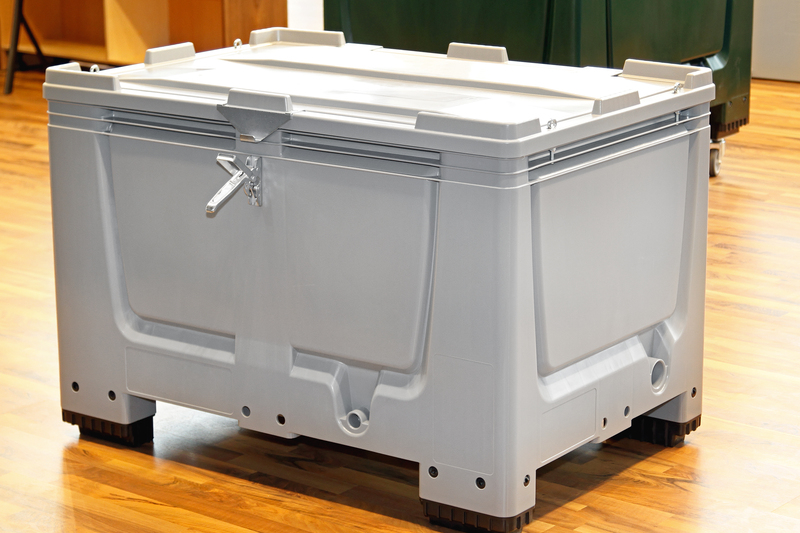Preserving Your Freezer: A Comprehensive Storage Approach
Posted on 19/06/2025
A modern home relies on efficient and reliable cold storage. Preserving your freezer and adopting the best storage practices ensures that your food maintains its quality, taste, and nutritional value over time. With the ever-increasing cost of groceries and food scarcity concerns, smart freezer habits play a pivotal role in every household. In this comprehensive guide, you'll learn how to maintain your freezer, optimize food organization, and safeguard your investments with freezer-friendly storage techniques.
Why Taking Freezer Preservation Seriously Matters
Maintaining your freezer isn't only about preventing ice build-up. It directly affects your food's freshness, flavor, and period of shelf life. A neglected freezer can lead to food spoilage, higher energy consumption, and even premature appliance failure. Implementing a comprehensive storage approach helps you:
- Improve food safety: Reduces the risk of bacterial contamination and freezer burn.
- Save money: Prevents wastage due to spoiled or forgotten items.
- Maximize capacity: Efficient organization ensures you use every bit of available space.
- Enhance efficiency: A well-preserved freezer cools efficiently, saving on energy bills.
The Science Behind Freezing and Food Preservation
Understanding the fundamentals of freezing is crucial for preserving your freezer and everything within it. Freezing halts the growth of microorganisms by lowering food temperature below 0?F (-18?C). While it doesn't kill bacteria, it stops their activity, effectively preserving perishable items for months or even a year. However, improper freezing and storage may lead to freezer burn, texture breakdown, and loss of nutrients.

Maximizing Freezer Longevity: Maintenance & Care
A key part of freezer preservation isn't what you store, but how you care for the appliance itself. Here's your step-by-step plan for keeping your freezer in top condition:
Routine Cleaning
- Schedule regular cleaning: At least twice a year, unplug and completely empty your freezer. Wash all surfaces with a mix of baking soda and warm water, then dry thoroughly.
- Dealing with odors: Place an open box of baking soda or a small bowl of coffee grounds inside to neutralize lingering odors.
- Wipe up spills promptly: This prevents sticky residues from harboring bacteria or affecting other stored goods.
Defrosting Best Practices
- Manual defrost: If your freezer lacks auto-defrost, defrost it whenever ice buildup exceeds a quarter inch. Remove all items and allow ice to melt naturally, using towels to absorb water.
- Don't chip at ice: You risk damaging the freezer walls or coolant lines. Instead, let it melt or use a gentle fan for faster drying.
- Restart safely: Only plug the freezer back in once fully dry.
Monitor Temperature Consistently
Maintaining the correct temperature (0?F or below) is critical. Fluctuating temperatures can ruin sensitive foods. Consider investing in a small, battery-operated freezer thermometer for continuous monitoring. Some advanced freezers offer digital displays for extra assurance.
Seal Integrity
- Check door gaskets: Inspect the rubber seal for cracks or deformation every few months. If you notice frost inside, a leaky seal may be the cause.
- Fix or replace as needed: Damaged gaskets allow cold air to escape, spiking your energy bills and reducing freezing efficiency.
Organization & Airflow
- Don't overfill: Jam-packed freezers restrict airflow, causing inconsistent cooling and higher energy usage. On the other hand, an almost empty freezer works harder to keep cool. Strike a balance, keeping the space about 70-85% full.
- Arrange for ventilation: Always allow a couple of inches of space between the food and the freezer walls for maximum air circulation.
Mastering Food Storage: Preserving Your Freezer's Contents
Food storage techniques matter as much as appliance care. Here are proven strategies for maximizing your freezer's preservation power:
The Best Containers for Freezing
- Avoid standard plastic wrap: Thin wraps are not airtight and invite freezer burn.
- Use freezer-specific bags: Heavy-duty, zip-top bags with double seals are ideal for flexibility and airtight closure.
- Opt for rigid containers: BPA-free, freezer-safe plastic or glass containers prevent crushing and preserve shape. Make sure lids are secure.
- Utilize aluminum foil and vacuum sealers: Both provide superior protection, especially for meats and produce destined for extended storage.
Labeling & Tracking Methods
- Always label items: Write the food type and freezing date clearly (use waterproof markers or labels).
- First-In, First-Out (FIFO) System: Place newer items to the back, consuming older products first to keep inventory fresh.
- Consider a freezer inventory chart: Keep a whiteboard or spreadsheet nearby to track what you have, cutting down on waste and over-purchasing.
Optimizing Freezer Space
Strategic arrangement can make a dramatic difference in usability and efficiency. To maximize your freezer space:
- Portion and flatten: Store pre-measured meal portions by flattening them in bags. Stacked bags use less space and defrost faster.
- Group similar items: Keep meats, vegetables, baked goods, and ready meals separate, using bins or baskets within the freezer for easy access.
- Use open shelving: Upright freezers with shelves make it easy to sort and locate frozen foods quickly.
Understanding Freezer Burn: Causes and Prevention
Freezer burn occurs when air reaches the food's surface, drying it out and creating grayish-white patches. While food with freezer burn is still safe to eat, texture and flavor suffer. Prevent freezer burn with the following tips:
- Always cool food before freezing: Hot foods cause moisture to condense and freeze as frost inside containers.
- Eliminate air: Press excess air from bags before sealing, or use vacuum sealers for the tightest fit.
- Seal tightly: Double-wrap or use containers with secure lids for longer-term storage.
- Minimize temperature fluctuation: Avoid leaving the freezer door open unnecessarily.
Recommended Storage Times for Popular Foods
A vital part of freezer preservation is understanding the longevity of different ingredients. Here are general guidelines for maximum storage:
- Poultry: 9 to 12 months (whole), 6 to 9 months (parts)
- Beef steaks/roasts: Up to 12 months
- Ground meats: 3 to 4 months
- Fish: 3 to 6 months (fatty), up to 8 months (lean)
- Vegetables: 8 to 12 months (blanched before freezing)
- Baked bread: 3 to 6 months
- Soups and stews: 2 to 3 months
Pro Tip: For lasting freshness, consult the USDA or local guidelines for updated food storage recommendations.
Prep, Pack, and Freeze: Step-by-Step Guide
- Plan ahead: Choose top-quality ingredients and remember that freezing can't improve the quality--it only preserves it.
- Pre-treat appropriately: Blanch vegetables, pre-cook meats if desired, and allow all food to cool completely before packaging.
- Choose the right container: Use only freezer-safe, airtight options for every item.
- Label each item: Include contents, preparation date, and suggested use-by date.
- Freeze efficiently: Lay packages flat, ensuring cold air can circulate freely. For rapid freezing, use "quick freeze" settings if available.
- Monitor and rotate: Regularly check your inventory and shift older items to the front for prompt use.
Avoiding Common Freezer Storage Mistakes
When it comes to preserving your freezer and maintaining food quality, awareness of common pitfalls is half the battle. Here are the most frequent mistakes and how to avoid them:
- Overloading the freezer: Makes it harder for cold air to circulate, causing frost build-up and uneven freezing.
- Neglecting to label items: Leads to "guesswork" and unnecessary food waste when items become unrecognizable.
- Leaving the door open: Raises interior temperature, risking partial thaw and re-freeze cycles that harm food texture.
- Ignoring frost build-up: Thick frost restricts storage space and forces the freezer to work overtime.
- Storing unsuitable packaging: Avoid thin plastics and grocery bags that don't protect against air or moisture entry.
Energy Efficiency: The Green Side of Freezer Preservation
Freezer preservation techniques also drive home energy savings. Efficient organization reduces door-open time, and keeping your freezer well-stocked (but not overcrowded) helps it retain cold air better. Use these bonus tips to further cut costs and environmental impact:
- Location matters: Place your freezer in a cool, dry area away from sunlight or heat-producing appliances.
- Don't ignore the coils: Vacuum dust from condenser coils at least twice a year to maintain optimal efficiency.
- Upgrade seals and insulation: Old freezers often benefit from replacing door gaskets and adding insulation for better cold retention.
- Set the right temperature: Lower than 0?F wastes energy, while higher can shorten food life. A thermometer helps you find the sweet spot.
Preserving Your Freezer: Smart Upkeep and Safety Tips
- Power outage prep: If the power goes out, keep the freezer door shut as much as possible. Foods can usually stay frozen for up to 48 hours in a full freezer (24 in a half-full one).
- Avoid liquid spills: Place items vulnerable to leaks (like soups) in a tray or bin to catch drips and protect other foods.
- Tame odors: Clean promptly and use odor absorbers to prevent unpleasant smells naturally spreading.
- Supervise children: Ensure children do not leave the freezer open or rearrange carefully stacked items.

Embracing a Freezer-Friendly Lifestyle
By following a comprehensive storage approach, you can take full advantage of your freezer as a tool for convenience, savings, and food security. A little know-how, regular maintenance, and smart organization will go a long way toward preserving your freezer and everything inside it. With these strategies, you'll minimize waste, lower grocery bills, and always have ingredients on hand for stress-free meals.
Start today by cleaning out your freezer, adopting improved storage methods, and implementing fresh labeling habits. The results will speak for themselves in fresher food, smoother mealtimes, and a reliably preserved freezer for years to come.
Conclusion
Preserving your freezer isn't a one-time task but an ongoing commitment to quality, safety, and efficiency. Implementing these comprehensive storage and maintenance techniques will maximize both the lifespan of your food and your appliance itself. Remember: care for your freezer, and it will take care of you.
With these expert strategies, you're now prepared to master the art of freezer preservation and enjoy the full benefits of home-cold storage all year round.
